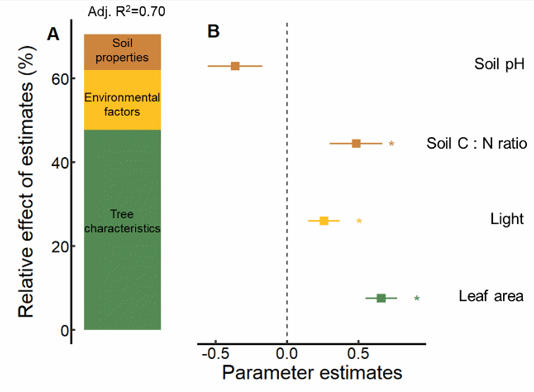How Temperate Forest Canopies Absorb Atmospheric Nitrogen Dioxide
Researchers at the Institute of Applied Ecology, Chinese Academy of Sciences (CAS), have provided new quantitative evidence showing how tree canopies in temperate forests absorb nitrogen dioxide (NO2) from the atmosphere. The study provides new perspectives on nitrogen cycling between the atmosphere and forest ecosystems, helping to understand how trees take up nutrients and store carbon. The findings were published in Plant, Cell & Environment under the title “Tree saplings readily take up NO2 during foliar 15NO2 fumigation.”
Nitrogen dioxide, one of the major atmospheric pollutants, can enter forest ecosystems through a process known as dry deposition, in which gases are directly absorbed by the leaves of the forest canopy. In nitrogen-limited ecosystems, canopy uptake of NO2 can serve as an important source of nitrogen for plants, potentially influencing ecosystem productivity and carbon sequestration. Despite this ecological significance, quantitative assessments of canopy NO2 absorption have been limited.
The research team, led by Prof. KANG Ronghua, conducted a controlled 15N isotopic tracing experiment using saplings of four dominant tree species found in northeastern China’s temperate forests. The saplings were exposed to NO2 for eight hours under varying light and soil nitrogen conditions, enabling researchers to track the absorption and distribution of nitrogen in different plant organs.
The study revealed significant differences among tree species in their ability to take up NO2. Leaf area was identified as a major factor explaining these differences. Under light conditions, NO2 uptake increased by approximately 8–34 percent compared to dark conditions, largely because stomata (tiny pores on leaf surfaces) remain open during the day, facilitating gas exchange. Soil nitrogen addition produced contrasting effects: it enhanced NO2 absorption in Quercus mongolica (Mongolian oak) by approximately 29 percent but suppressed it in Larix gmelinii (Dahurian larch) by roughly 42 percent. These differences suggest that trees regulate their NO2 uptake in response to their nitrogen status, according to the researchers.
After the exposure period, most of the absorbed nitrogen was stored in the leaves, suggesting that foliar tissues serve as the primary reservoir for atmospheric nitrogen assimilation. Extrapolating from the sapling data, the researchers estimated that temperate forest canopies could assimilate approximately 0.51 kilograms of nitrogen per hectare per year through NO2 uptake.
These findings deepen our understanding of how forest canopies interact with atmospheric nitrogen and improve nitrogen cycling models on a larger scale. By measuring NO2 absorption within the forest canopy, this study demonstrates the critical ecological role of tree leaves in linking air quality, nutrient cycling, and forest health.

Figure 1. The factors affecting the NO2 absorption capacity of tree canopies and their relative contributions.



